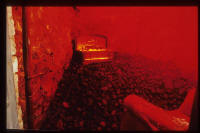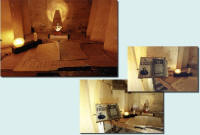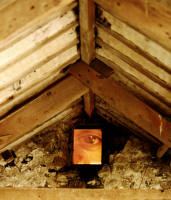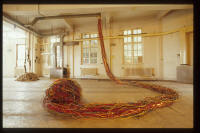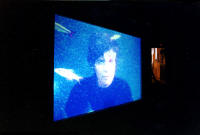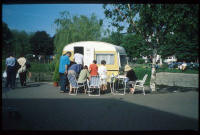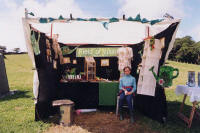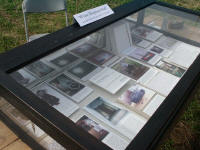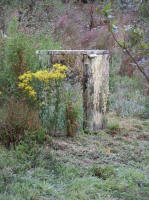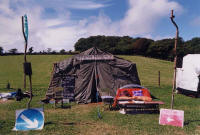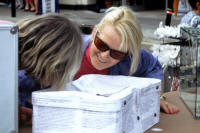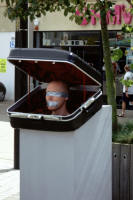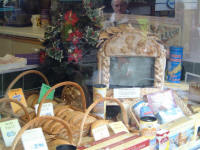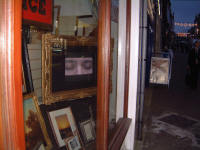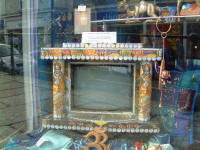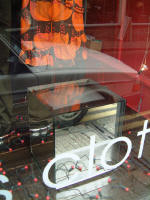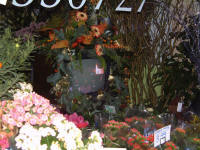| artcornwall | ||||||||||||||||||||||||||||||||||||||||||||||||||||||||||||||||||||||||||||||||||||||||||||||||||||||||||
| home | features | exhibitions | interviews | profiles | gazetteer | links | archive | forum | ||||||||||||||||||||||||||||||||||||||||||||||||||||||||||||||||||||||||||||||||||||||||||||||||||||||||||
|
PALP archive Penwith Artist-led Projects (PALP) was a highly successful series of visual arts initiatives that emerged at the end of the 1990s. Penwith is the most deprived of all the districts in Cornwall, and indeed during the time that PALP was active, it was one of the most deprived in Europe. PALP, as an ambitious artist-led venture, was one of the first of its kind in Cornwall. It successfully attracted money from the Arts Council, and generated a lot of interest amongst the local population. PALP's activities centred around five exhibitions which are described in the following five sections. A sixth project 'Coal/Salt/Tin' emerged from a collaboration between PALP and artist groups in Newcastle and Leeds - PALP members were involved in the commissioning of the work, but artists from Cornwall did not otherwise contribute. A statement written by the group conveys some of the thinking shared by the PALP members at the time that they originally came together:
'Penwith Artist-Led Projects (PALP) is a collective of inspired and insightful artists who want to see community action as arts-led, not economy- or politics-led, in an area of the country historically famous for its art but in decline in relation to recent movements in the art world. PALP’s manifesto focuses on workspace issues and support structures for visual artists in Penwith, but also expresses a wish to link with other artists and collectives in the UK and Europe who might find new ways of working together in different spaces and places to reach new audiences. Despite the presence of a major art school in Falmouth, there is a peculiar, obstinate denial of contemporary art, particularly site specific and non-commercial by local and younger emerging artists in Penwith, Cornwall. The peninsula is home to a significant slice of Modernist experimentation and yet in more recent years, with the weight of the tourist pound, much of this work has become economy led. Often such work avoids explicitly transgressive and experimental forms and ideas of the contemporary visual arts. It is from within this debate and the debate around workspace and exhibition space that PALP was formed. The Penwith Housing Trust commissioned a study into these very issues in 1998. Fergus Murray the founding member of PALP, was commissioned by the Trust to produce a feasibility study. Through this he identified a group of like minded artists all sharing the same problems and seeking their solutions outside of the region. A series of meeting ensued over the next year and a small development grant from South West Arts was secured in order to establish a database and continue to investigate the possibilities and sustainability of artist led groups'.
The core members of PALP were Susan Bleakley, Gillian Cooper, Tessa Garland, Amanda Lorens, Marion Taylor and Lucy Willow. Fergus Murray was an associate member.
Please feel free to send artcornwall any additional documentation
Shed Boscathnoe Farm, Heamoor, Penzance 11-13 August 2000
Gillian Cooper’s ‘Thicker than Water’, installed in a large, open-fronted shed using the floor space, has around seventy metal pails and half that number of brushes (scrubbing brushes and hairbrushes) perched on the pails, or abandoned on the floor. Some of the pails have tipped, all their contents have evaporated. The title suggests blood ties and family connections, and the objects invite classification into family groups, such as types of brushes. The work signifies domestic toil, and going into service. Amanda Lorens’ ‘Bath’ transforms the archetypal abandoned bath one always finds outdoors on a Cornish farm by cladding it inside and out in white towelling. The clean and the dirty, bath and towel, become one, absorbing the elements during the three days’ of the show. Cleverly, the towelling stops at a tide line, so that the rusty base of the bath is left. Amanda’s ‘Coal Shed’ turns from the water and air of the bath to fire and earth. An electric fire sits atop a heap of coal in a bricked coal shed. A chair is placed in front of the fire. The small space is stiflingly hot. Disconcertingly, a vicious fire, like a building burning down, crackles and roars away through an installed tape-loop, creating a disorientating spontaneous combustion without real markers of flame and smoke. Susan Bleakley lights up the corrugated-roofed donkey shed with small night-lights. It is as if it is Christmas in August, as we enter the cobble-floor stable in anticipation, to greet a strange amalgam of fairy story and postmodern superwoman. Here is the outfit of ‘Donkey Girl’ hanging from a beam. Above a pressed white dress with scrubbing brushes at knee height (donkey girls are working girls) is a pair of silver-grey donkey ears. A broom completely gilded with gold stands by the outfit, and at the foot of the broom is a small pile of gold-gilded donkey shit. Some transformation is happening. There is more gilded shit mingled with the real stuff in a heap topped by golden straw. It is a changing room for a super-heroine. In her ‘Plant Labels and Plants’, Sue infects small area of garden with vibrant, brightly-coloured plastic plants, described by ghastly names written on accompanying sticks of alabaster, such as ‘Mists of Malice’. This is the alternative garden centre, the future Eden. In a three-piece suite, Tessa Garland also makes futuristic flowers. On a theme of surveillance, ‘Prelude’ is sited above the ‘shed’ that is the outdoor loo. It is a construction at giant’s height, accessible by ladder, into which you look to be greeted by an eye looking back. ‘Big Flower is watching You (Part 1)’ is reached by a trail through the garden, leading to the ‘shed’ that is a roomy plastic tunnel, a small hangar. Tendrils of red filler-foam have greeted you on your walk, and now you walk into a hothouse of red Amazonian flowers and overhanging vines. The flowers reach out with their finger-like petals, and at the centre of one is a surveillance camera. In ‘Part 2’ of the same piece, you are led away to a garden shed where a CCTV screen glows with the image of the watching flower. You see others watching the flower that is watching them while you watch, distanced, in a hothouse of surveillance and simulation. Fergus Murray’s ‘The Drying Room’ is an alternative peepshow. At the entrance to a small shed you lift a cloth veil to reveal a room packed with hanging and drying forms, lit by a hurricane lamp. This could be tobacco, or hanging meats, or the fingers of dead gardeners. The impact comes from the stillness of the piece. It is like the model for a Dutch interior painting, in which the model itself is now given an airing as a room of hanging history, episodes drying out, events desiccating. Marion Taylor’s ‘Losing Time’ explicitly adopts the theme of time in a small room illuminated by torchlight, but here, time is explicitly renewable, through musical score and rhythm. Set against a clock-face circle of light on a back wall, a metronome ticks. The room is stacked with pianola rolls and sheet music is scattered on the floor. Time is both suffocating and opens up, through rhythm. An egg timer and an everlasting flame signify time lost and time regained. Lucy Willow’s ‘Shed, Shed’ plays on two meanings of shed, as shedding skin or fur (or sheep’s wool in this case), and shed as shelter, for a childhood moment, or a revelation of quiet interiority in a child-like meditation. A trail of sheep’s fleece leads through a portion of the garden to a small concrete shed, coiling around a child’s chair and flopping onto a cushion. At the end of the expansive thread is a French-knitting bobbin. Is the ‘shedding’ an outgrowth from the small, or a return to the seat of wisdom that is a child-like regression to a small quiet space? How can such a show be judged? The work speaks for itself, but, given that PALP’s manifesto calls for ‘working together in different spaces and places to reach new audiences’, the show must be judged an unqualified success. 350 people turned up on the opening night, extraordinary for a ‘small’, ‘local’ show. this is an extract from 'AWAY FROM THE LIGHT' by Alan Bleakley: the full essay is available as a PDF file
Palpitations The Exchange, Penzance 23rd-25th February 2001
PALP (Penwith Artist-Led Projects) is a collective of artists aiming to re-establish West Cornwall as a locus of progressive and experimental artistic activity. ‘PALPitations’, the group’s second site specific show, took place on the ground floor of the otherwise disused BT exchange building in Penzance over the last weekend of February. The space is vast and still haunted by its past; remnants of its former usage proliferate, providing a loaded context so markedly different from the attempted neutrality of the art gallery. Here the signs of an industrial past, intimately linked with ideas of communication, comprehension and exchange, are the springboard and inspiration for this event. A relationship of mutual dependence is enjoyed: the building and its history prompts, sustains, and layers the meanings of these installations, and the installations serve to reinvigorate and revitalize the dilapidated space, injecting it with renewed purpose. A sense of vitality and humour is introduced early on in the exhibition with Tessa Garland’s Aquarium. The viewer passes a fish tank at the back of which a small camera is installed. Seen through this aquatic environment, the various intrigued reactions of viewers are projected on a large screen in the next room. Having already entered the work, we are then afforded the luxury of watching others, similarly unknowing, loom foolishly into vision to join the fish and the bubbles. Playing with notions of spectatorship and the viewer’s role in completing the work of art, as well as providing numerous giggles, Garland’s piece augurs a fresh and witty ambience. In the dwarfing, open, industrial main exhibition space, the installations and constructions are more firmly rooted, both thematically and aesthetically, to their context. Both ideas related to and mechanisms of communication dominate: from voicemail to cans on a string, and from transatlantic cables rescued from the seabed to snake-like concrete tongues writhing out of an old GPO crate. In Anagram, Carole Dodds uses anagrams of the name Alexander Graham Bell to provide bizarre and nonsensical subject matter for a series of images resembling primitive digital drawings. Although visually unexciting, this series stands as a witty new method for the generation of imagery in a way that still relates to the exhibition context. In the three-part work Cable, Marion Taylor employs the physical vehicles of communication: huge bundles of wires, cable from the ship that laid the transatlantic cable off Porthcurno, and a piece of such cable retrieved from the seabed. These elements are arranged monumentally, occupying a large amount of space and using that space to suggest undulation, conveyance, connection and dislocation. It is in two dark rooms at the back of the building that the potential of this evocative context is most successfully activated. In Dead Silence by Amanda Lorens, five monitors showing videos of human mouths are set on plinths and covered by draped white sheets. Although the mouths appear to be talking, nothing can be heard. The room is dark, lit only by the filtered light of the veiled screens. The pervading quality is a feeling of absence; a ghostly and sombre poignancy issues from the distanced and dislocated human presences. Linked to the exchange building in the focus on the mouth and on speech, and pertaining to its history in the evocation of the activity that once invigorated this space, Lorens nevertheless transcends this specificity to address broader ideas and provoke deeper reactions. The viewer is moved to contemplate such concepts as transience, mortality, and the impossibility of true communication. Louise Short’s Feeling Faint also utilises the moving image to evocative effect. Using several projectors, films of details of the room in which the piece is installed are imposed onto those details. For example, film shot of a stopped clock is projected onto that clock (and so with a screw, a clothes hanger, a bare corner). The projected images move with Short’s breath as she was shooting, never aligning with the reality from which they were taken, but rather always floating and hovering around it. There is no attempt to create new realities, only to highlight aspects and details, previously mundane and aesthetically undistinguished, to be perceived differently. This project has nothing to do with self-expression, nor politics per se, but rather is the result of meditation on the nature of this space, as well as on the perception of spaces in general. The hovering projections have the effect of layering reality, allowing poetic connections to seep between the layers. Cohered by the physical space and industrial history of its context, this show was a fascinating event. Although not all the work shown was entirely convincing (some pieces lacked visual impact), the weaker elements were validated as part of an innovative and vigorous project. Seeking to re-engage with social spaces and re-integrate art and modern life, PALP is sure to make considerable impact on the largely commercial, gallery-based Cornish art scene. The artists included in ‘PALPitations’ were Carolyn Black, Tessa Garland, Carole Dodds, Gillian Cooper, Sue Bleakley, Marion Taylor, Amanda Lorens, Louise Short, and Nick Harpley.
Ed Krčma, March 2001
Field of Vision Tremenheere Sculpture Park, Penzance
Wish you were here Various venues, Cornwall
'Wish you were here' was an exhibition featuring 20 artists from all over the UK who responded to a brief to make work for 20 suitcases in response to a national advertisement. The show toured to a large number of outdoor public venues in Cornwall including: Trebah Gardens, Falmouth; Newquay Airport; Jubilee Pool, Penzance; and Lemon Quay, Truro.
60 seconds of hope Various venues, Penzance, Christmas 2004
'60 seconds of hope' was an exhibition of video work in various public locations in Penzance. Curated by Rory McDermott, with help especially from Lucy Willow and Allesandra Ausenda, it comprised a compilation of silent videos, one minute long, all depicting symbols of hope. The videos were showed on especially customised monitors, that integrated the monitor screen fully into its individual setting. The project was initially advertised in 'The Cornish Guardian', the local paper:
Just a minute! when was the last time you
spent 60 seconds feeling hope full.
Contributions were subsequently received from a wide range of individuals, organisations and community groups, only a couple of which would have described themselves as artists. All the videos submitted were included, in a way that emphasised 'hopeful' themes of inclusion and equality. The following report was written by PALP afterwards:
REPORT : 60 Seconds of Hope – PALP Dec 2004 The main purpose of this project was to build upon and develop the information gained in the two previous projects by PALP; Field of Vision 2002 and Wish you were here 2003 and to create opportunities for engagement and involvement in the making of small-scale video art within the local community. We decided to explore issues of accessibility within a small town in West Cornwall (Penzance) given that this area has in the last 10 years raised its cultural profile. Penzance benefits from the cultural triangle of Tate St Ives, Newlyn Art Gallery, and the Falmouth Art College. We chose to show the work in shop windows on customized televisions on the streets of Penzance. Effort was made to reassure businesses that no extra work on their part would be needed to participate in the project as this seemed to be an important issue for most of the shops. For this reason DVD’s were used connected to the monitors. They were encoded to start on insertion and repeat play automatically. This was fundamental to the smooth running of the project. We also gave them the project managers’ phone numbers so they could be called at any time to give technical assistance if problems arose. This allayed their fears of having to take any responsibility outside their normal working remit. During the project the managers were only called out twice on simple technical problems although visits were made almost every day to check all the TVs were running and the shops were happy. All shops commented that many people stopped and spent time looking at the videos and that many people asked about the project. Only one shop found it disconcerting having people looking into the window because it didn’t normally happen and they felt observed, as the view in through the window played straight onto their working area. The other shops all felt good about having participated and at observing people’s individual interpretations of the theme ‘hope’. The shops were encouraged to help with the placing of the TVs and were consulted as to how the TVs should be customized. The idea was that the TVs should fit appropriately into the normal presentation style of the shop window. It would have been possible to engage more shops in the project but wanting the participating shops not too close together and well placed were considerations that were important, given the small-scale nature of this project. Over the 10 days a modest estimate of over 2,500 will have seen the project and given the subtle and quirky look of the projects’ presentation it is an excellent example of how a small scale community project can engage and inspire thousands people to think about ‘hope’at the christmas period which brought an often missed perspective to this time of year, in its most secular terms being the increase of light, hence the idea of hope. The project’s proposal was presented to the public in the Cornishman, the local newspaper for the West Cornwall area. (See enclosed cutting and press release, which was also presented on the websites of Creative Skills Consortium and Flickernow, a new Cornish organization set up to promote film making in the South West. Flyers were also placed on notice boards in many relevant local venues. Submissions were received over the period of one month; there was no censoring of the work with all the submissions being showed. We received 30 video works from playgroups, schools, children, writers, artists and individuals from the local community. One of the most interesting aspects was the mixture of work by people using video for the first time, resulting in effective communication of simple ideas, as well as by those more experienced in the visual language of this relatively new medium. We think it would safe to say that the project was a great success allowing large numbers of the local community to feel involved and inspired by their own sense of creativity and adding to the feeling that they live and partake in one of the most interesting and culturally fertile areas of the country.
Penwith Artist Led Projects 2005
|
||||||||||||||||||||||||||||||||||||||||||||||||||||||||||||||||||||||||||||||||||||||||||||||||||||||||||

